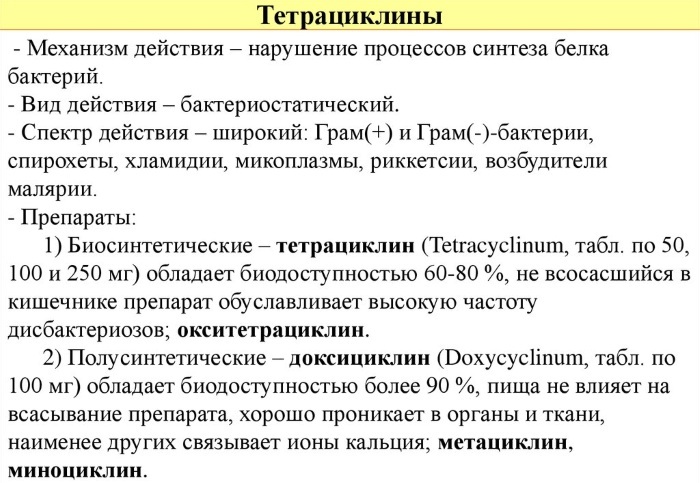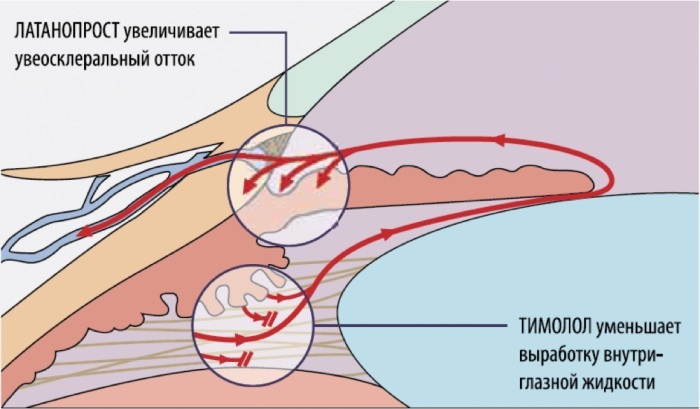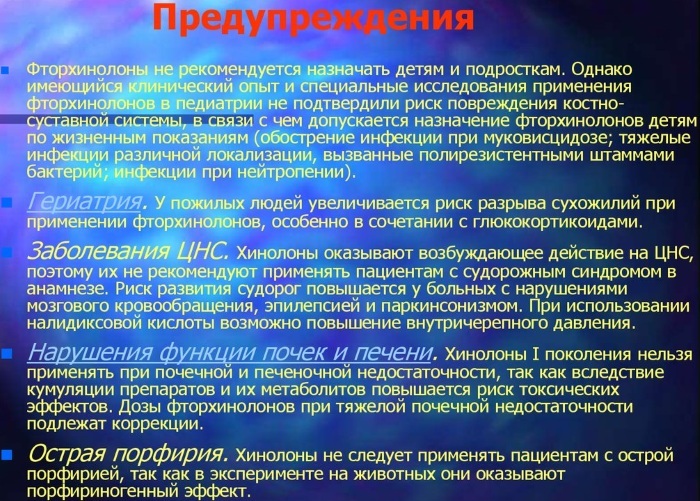The main reason for the appearance uncomfortable sensations in the external hearing aid - otomycosis, which can only be dealt with thanks to antifungal drops.
Since the disease can last for a long time, and remission is always replaced by an exacerbation, for effective treatment, the patient must daily instill a medication in the ears, which is intended to combat fungal lesions of the auditory apparatus. Otherwise, the patient will face acute headaches, dizziness. Serious hearing problems are not excluded.
Record content:
- 1 Types of fungal infections of the ear
- 2 Advantages and Disadvantages of Fungus Ear Drops
- 3 Active substances in the composition of preparations for instillation
- 4 Features and rules for the use of drugs
-
5 Review of effective antimycotic ear drops for adults
- 5.1 From yeast
- 5.2 From mold
- 5.3 From itching
- 6 Drops allowed during pregnancy and lactation
- 7 Drops for children
- 8 Where to buy antifungal drops?
- 9 Drug prices
- 10 Video about fungus in the ears
Types of fungal infections of the ear
Antifungal drops in the ears should be selected by an otolaryngologist who performed the necessary examination of the patient and established what type of mycosis struck the skin in the hearing aid.
In total, doctors identify 3 types of fungi that can develop on the surface of the skin in the ear canal:
- Moldy (penicillium, aspergillus).
- Yeast-like (Candida).
- Particularly pathogenic (dermatophyte, actinomycete).
For the treatment of a fungal infection of the ear, a special approach and the selection of effective medications are required.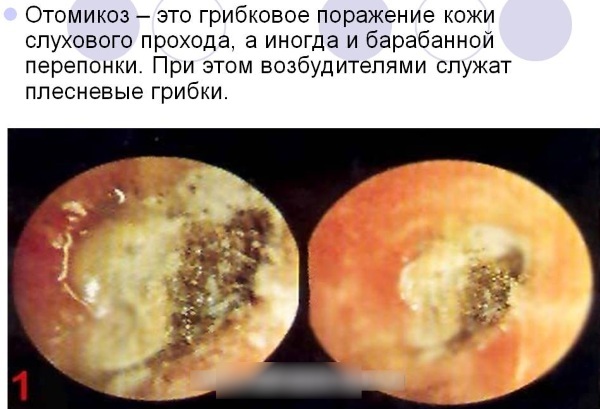
To prescribe treatment and select the optimal therapeutic course, the otolaryngologist determines the area of damage to the hearing aid:
- Less often, a fungal infection affects the middle cavity and the outer ear, since this is possible only with the most extensive lesion of mycosis. In such a situation, the condition of the tympanic membrane worsens, since under the influence of pathogenic microflora, the tissues begin to inflame and flake off.
- In 20% of all cases, mycoses are diagnosed in the tympanic cavity. Effective therapy should be based on oral administration of antifungal medications.
- In 50% of cases, the fungal infection is localized only on the surface of the skin of the outer part of the hearing aid. To combat mycosis, it is necessary to use preparations of a local principle of action - antifungal drops.
Only timely started treatment can prevent the deterioration of the patient's condition. In the absence of high-quality therapy, absolute deafness, infection of nearby organs, as well as the transition of the disease to a chronic form are not excluded.
Advantages and Disadvantages of Fungus Ear Drops
Antifungal ear drops have not only positive but also negative characteristics that patients should consider before using antibacterial drugs.
The main benefits include:
- A high percentage of tolerance of antibacterial drops by patients. Modern antifungal drugs with an antibiotic are well tolerated by those who do not have an increased sensitivity to the composition of the drops.
- High therapeutic efficiency. After the first use, the drug acts on pathogenic microorganisms, depriving them of their ability to reproduce. Already in the first days of therapy, the patient notices a significant improvement in his condition and a decrease in the intensity of the manifestation of discomfort in the ear canal.
- Ease of use. Antifungal drops must be accompanied by instructions for using the medication. The patient can take drops with him on the road, due to which the frequency of instillation of the medication will not be disturbed.
In patients with hypersensitivity to the components of the drug, a hyperergic reaction to the active components of the drug may occur. In such a situation, the patient should contact a qualified otolaryngologist who will help eliminate allergy symptoms and select a good analogue.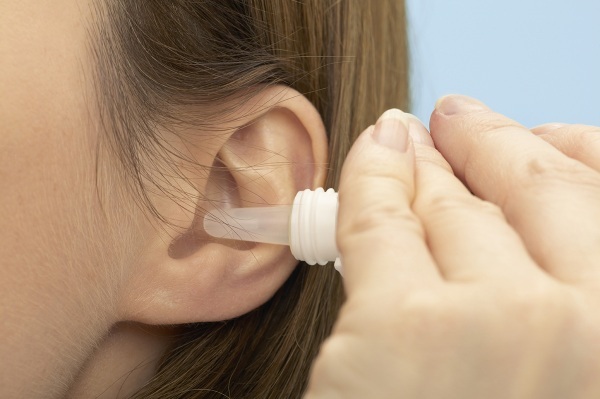
The disadvantages of antifungal drops include:
- The presence of contraindications. Many drugs are contraindicated in patients with tympanic membrane perforation. Otherwise, toxic damage to the hearing aid is possible. Some types of ear drops cannot be used by pregnant women or during lactation.
- Decreased protective functions of the immune system. Antifungal drugs prevent further growth and reproduction of pathogenic and healthy microflora in the body.
In order for antifungal drops to affect the patient's body only from a positive side, it is necessary to adhere to the recommended dosage of the drug and the duration of therapy.
Active substances in the composition of preparations for instillation
Drops prescribed by otolaryngologists contain various active substances, the combination of which has a positive therapeutic action, and also helps patients cope with several microorganisms at once that can provoke the development of dangerous infectious pathologies.
Almost all antifungal drugs contain the following active ingredients:
- Antibiotics These are one of the main active ingredients that can have bactericidal or bacteriostatic properties. In the first case, the medicine helps to overcome the pathogenic microflora, and in the second case, the antibiotic blocks the formation of protein in the cell of the pathogenic microorganism.
-
Glucocorticosteroids. This category includes hormones that have a powerful anti-inflammatory effect, eliminate puffiness, and also help get rid of itching and redness of the skin.
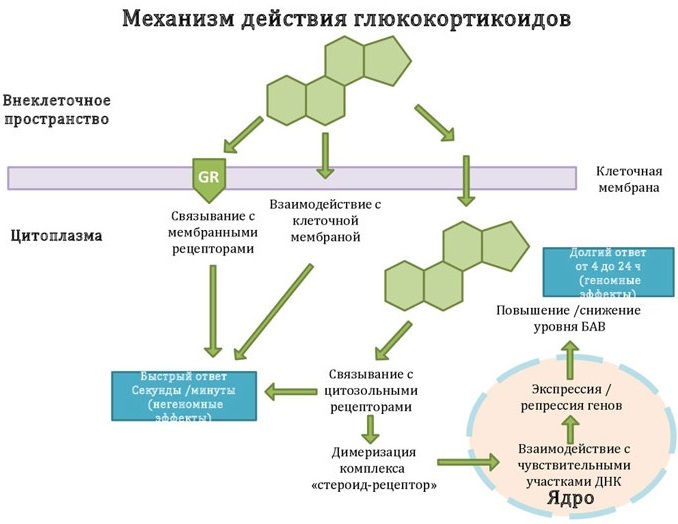
- Antifungal components. These substances are aimed at effectively fighting fungi. Antifungal drugs demanded in traditional medicine affect the synthesis of components that are part of the cell wall of a pathogenic microorganism. Thanks to this, it is possible to destroy the fungal cells.
- Elimination of painful symptoms. Many drops contain a special anesthetic that can help reduce the intensity of pain.
When choosing the right antifungal drugs, otolaryngologists take into account the type of fungus, the area of the lesion and the condition of the patient. Only in this case, the prescribed therapy will bring a positive effect.
Features and rules for the use of drugs
Antifungal ear drops are popular drugs in otolaryngology, which patients must use in compliance with certain rules and in a clear sequence.
Only with regular and correct use of the drug can the desired therapeutic effect be achieved:
- The first step is to carefully clean the ear canal. For this, you can use hydrogen peroxide or "Furacilin". If the patient decides to choose exactly "Furacilin", then he will need special instruments, therefore this option is most often used by otolaryngologists. But the patient can drip hydrogen peroxide into the ear on their own. The liquid must be held in the ear for 5-10 minutes, after which it must be allowed to flow out.
- The pipette used must be sterile. You can use a special polyethylene dropper, which is sold together with drops, or a regular pipette, bought separately at the pharmacy. Boiling is used to disinfect the latter.
- The patient should lie on his side and gently pull the earlobe down. To treat the child, the lobe is pulled up.
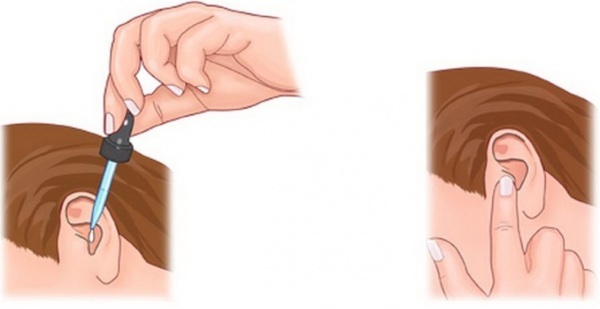
- The antifungal solution should be at room temperature, therefore, before use, the bottle with the healing solution is warmed up in the hands.
- A sufficient amount of the drug is taken into a pipette and instilled into the ear affected by pathogenic microorganisms.
- At the final stage of the procedure, the patient should apply a little pressure on the auricle and lie in this position for another 15 minutes.
The same procedure must be repeated for the second ear.
Review of effective antimycotic ear drops for adults
Antifungal drops in the ears differ not only in their composition, but also in indications, as well as contraindications that need to be studied in advance.
Otolaryngologists recommend that their patients use antifungal drops for treatment when the effect of pathogenic microorganisms is concentrated in the outer ear. You need to buy a drug in accordance with the type of pathogen.
From yeast
If, after examining the patient, the otolaryngologist determines that mycosis has developed against the background of yeast penetration into the hearing aid microorganisms, then a drug from that category of drugs will be selected for treatment, the composition of which helps to cope with yeast fungi.
The following funds are most effective:
- "Clotrimazole". The main active ingredient of the solution is clotrimazole at a concentration of 100 mg per 10 ml of the drug. This medication is used in the form of drops in cases where the patient is diagnosed with otomycosis in the area of the auricle and external ear. It is also used as a preventive medicine after middle ear surgery. "Clotrimazole" is forbidden to use the first 2 weeks of pregnancy, during lactation, as well as in case of individual intolerance to the components of the drops. The drug is recommended to be used at bedtime for 2 weeks. 4-5 drops must be instilled into the ear. In severe cases of the disease, the therapeutic course can last 30 days.
-
"Candibiotic". The drug contains the following active ingredients: beclomethasone dipropionate, lidocaine hydrochloride, clotrimazole and chloramphenicol. "Candibiotic" is intended for the treatment of allergic and inflammatory pathologies of the hearing aid organs.
 Otolaryngologists prescribe this medication to those patients who have been diagnosed with acute otitis media, otitis externa, as well as other diseases associated with the presence of fungal infections. The drug should not be used for the treatment of children under 6 years of age, if there is an individual intolerance to the components of the medication, as well as if the tympanic membrane is damaged. Dosage for the treatment of adult patients and children over 6 years old - 5 drops in a sore ear 4 times a day. The maximum duration of the therapeutic course is 10 days.
Otolaryngologists prescribe this medication to those patients who have been diagnosed with acute otitis media, otitis externa, as well as other diseases associated with the presence of fungal infections. The drug should not be used for the treatment of children under 6 years of age, if there is an individual intolerance to the components of the medication, as well as if the tympanic membrane is damaged. Dosage for the treatment of adult patients and children over 6 years old - 5 drops in a sore ear 4 times a day. The maximum duration of the therapeutic course is 10 days.
To avoid the manifestation of adverse reactions, before using antifungal drops, it is necessary to study the instructions attached to the drug.
From mold
Only an otolaryngologist can determine the type of fungus after examining the patient, which is why it is strictly forbidden to self-medicate. Otherwise, the use of an ineffective medication can negatively affect the patient's condition.
If the patient's ear pain is provoked by mold, then the following drugs are recommended:
- "Nitrofungin". The main active ingredient is chloronitrophenol, which is effective against trichophyton, microsporum, candida. The drug is intended to combat fungal infection of the hearing aid, otitis media. The use of the medication is prohibited for the treatment of children under 3 years of age, as well as in the case of a patient's hypersensitivity to the components of the medication. To achieve a positive therapeutic effect, the agent must be instilled 1 drop into each ear 3 times a day. The treatment lasts 2 weeks.
- "Naftifin". The main active ingredient is naftifine hydrochloride. The drug is effective in the fight against fungal infections of the hearing system, candidiasis, pityriasis versicolor and mycosis, which arose against the background of a bacterial infection. The described drops are forbidden to use during pregnancy and breastfeeding of the child, with the presence of scratches and wounds in the ear canal, as well as with intolerance to the components of the medication funds. To achieve a positive therapeutic effect, the medicine is instilled 1 drop into the ear before bedtime. The course of treatment should not exceed 4 weeks.
The duration of use of antifungal drops depends on the patient's immunity, the form and stage of development of the fungal infection.
From itching
In 85% of all cases, otomycosis is accompanied by severe itching in the ear canal. In such a situation, the patient can comb the areas that are affected by pathogens, which only aggravates the course of the disease.
To eliminate discomfort, otolaryngologists recommend using the following drugs:
- "Cresyl acetate". These drops not only fight fungal infections, but also relieve itching and irritation in the ear. The drug is indicated for otitis media and fungal infections of the hearing aid. "Cresyl acetate" is prohibited for use by pregnant and breastfeeding women, as well as in the presence of hypersensitivity to the components of the drug. It is recommended to use the product 4 times, 3 drops per day for 3 weeks.
- Dexamethasone. The drops contain the only active ingredient - dexamethasone (in the form of sodium phosphate). The medicine is used for otitis media, as well as for severe itching in the ear canal, the skin of which is affected by pathogenic microorganisms. The drug is contraindicated in chickenpox, purulent tissue lesions and the presence of perforation in the tympanic membrane. For the treatment of inflammatory processes, it is necessary to instill 3-4 drops of the medicine in each ear 3 times a day. The therapeutic course lasts 5 days.
During treatment, the patient must adhere to all prescriptions of the otolaryngologist and observe the dosage of the drug used.
Drops allowed during pregnancy and lactation
In the early stages of pregnancy, a woman's body significantly reduces its protective functions, which is why various pathogens can, after getting on the skin, begin their vital activity. For high-quality treatment, you need to choose the right medicine, since the fungus can reach the eardrum, harming not only the woman, but also her baby.
Allowed antifungal drops include:
- "Polydexa". The drug contains dexamethasone, polymyxin, and neomycin. The active ingredients have antimicrobial effect. The medicine is indicated for otitis media in acute form, infectious eczema of the outer ear, as well as fungal infection of the hearing aid. The medicine is not used for ventricular tachycardia, perforation of the tympanic membrane, hypersensitivity to active ingredients. Treatment regimen: 2 drops 2 times a day. The treatment can last for a maximum of 2 weeks.
- Tsipromed. The active component of the drug is the antibiotic ciprofloxacin, which belongs to the category of fluoroquinolones. The drug is indicated when a foreign object enters the ear canal, otitis externa and otitis media, infectious complications after surgery. It is forbidden to use the medicinal product in the presence of hypersensitivity to the components of the medication. This medication is not recommended for use without first consulting a gynecologist, so as not to harm the health of the child. Otolaryngologists recommend instilling 5 drops of the drug 3-4 times a day. The course of therapy lasts 14 days.
- "Candibiotic".
During pregnancy and lactation, drops can be used to combat pathogenic microorganisms only after prior consultation with a gynecologist or therapist.
Drops for children
Fungal infection of the ear canal in childhood is extremely dangerous, since many other pathologies can develop against the background of this disease.
Drops with an antibiotic are most effective, which allows you to cope with pathogenic microflora:
- "Otofa". The main active ingredient is rifampicin. Drops can be used to treat chronic and acute otitis media of various etiologies. The drug can be used in pediatrics regardless of the child's age. The main contraindications include the presence of individual intolerance to the components of the drug. The medicine is instilled in 3 drops in each ear 2-3 times a day. The treatment lasts 1 week.
- Otipax. The main active ingredients: lidocaine hydrochloride, phenazine. The drug is indicated for barotraumatic otitis media, acute and chronic otitis media, fungal infections. Otipax is contraindicated in case of intolerance of the constituent components, damage to the tympanic membrane. For babies under 1 year old, 2 drops are instilled, for children from 1 to 2 years old, the dosage is increased to 3 drops in 1 ear. For the treatment of children over 3 years old, it is recommended to use 4 drops. The medicine should be applied 2-3 times a day. The course of therapy is 10 days.
Before using the drops, you need to study the attached instructions in order to exclude the likelihood of developing adverse reactions.
Where to buy antifungal drops?
Antifungal drops are indicated in cases where pathogenic microorganisms have entered the hearing aid, due to which the patient experiences painful sensations. The medicine is instilled into the ears only in accordance with the instructions, since exceeding the permissible dosage can aggravate the patient's condition.
You can buy antifungal drops at the pharmacy, as well as via the Internet, but in the latter case, to make purchases should only be selected from a trusted online pharmacy to be sure of the quality of the purchased drug.
Drug prices
The cost of antifungal medicines depends on the region and the markup of a particular pharmacy chain. Almost all ear drops are sold without a doctor's prescription.
| Drug name | Average cost in Russia (rubles) |
| "Clotrimazole" | 200-272 |
| "Candibiotic" | 330-380 |
| "Nitrofungin" | 250-450 |
| "Naftifin" | 340-450 |
| "Cresyl acetate" | 250-380 |
| Dexamethasone | 115-230 |
| "Polydexa" | 134-186 |
| "Tsipromed" | 119-190 |
| "Otofa" | 189-260 |
| Otipax | 280-360 |
For the effective treatment of otitis media and the fight against pathogenic microorganisms, antifungal drops are used. In the course of treatment, the patient should regularly instill the medicine in the ears in the amount indicated in the instructions.
If the dosage and frequency of use of the drug are not observed, the development of adverse reactions is not excluded, which negatively affect the work of internal organs and may lead to hearing loss or complete loss hearing.
Author: Dorogokup Daria
Video about fungus in the ears
Malysheva will tell you what a fungus in the ears is and how to treat it:

